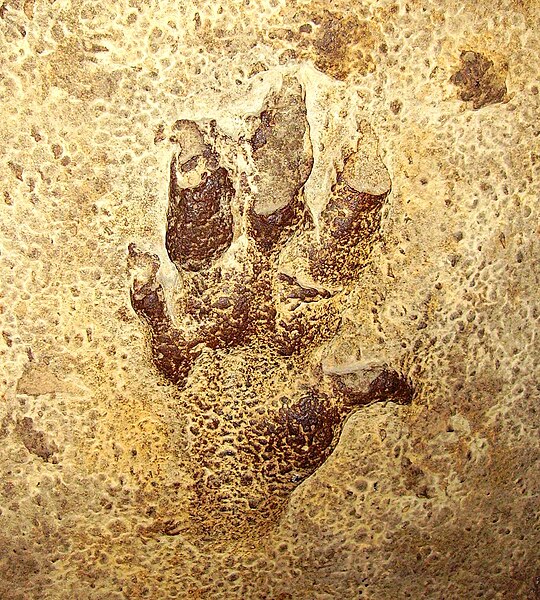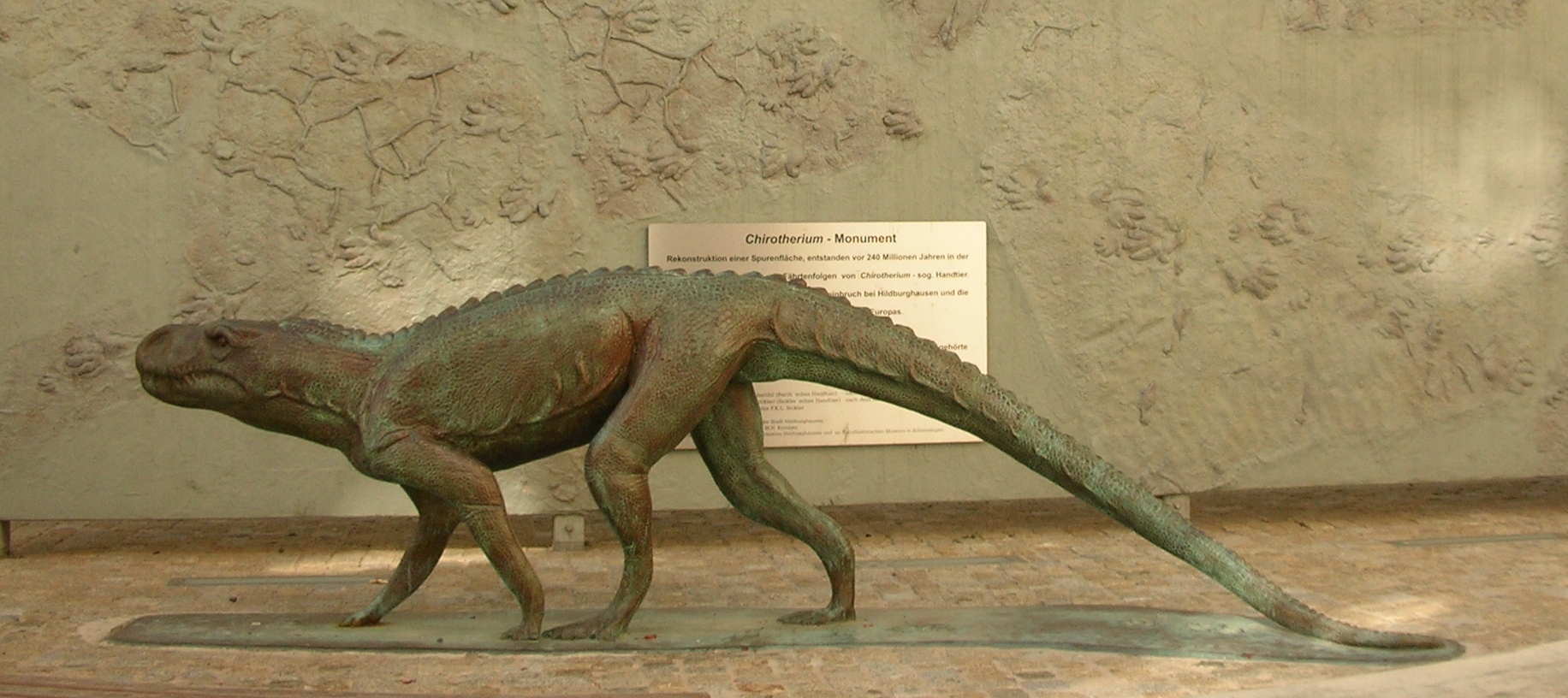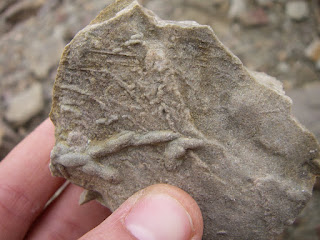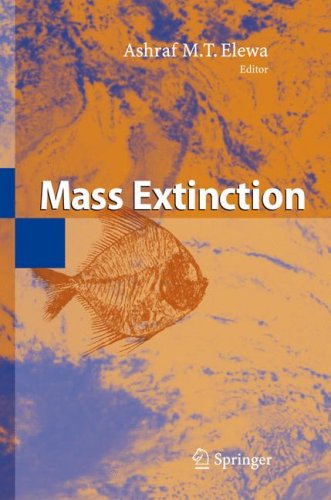Wednesday, December 31, 2008
Last Post 2008: 100 Earth Science Blogs
Tuesday, December 30, 2008
Off topic: My top records 2008!
 Fleet Foxes - s/t LP (Sub Pop)
Fleet Foxes - s/t LP (Sub Pop)www.myspace.com/fleetfoxes
 Lemuria - Get better (Asian man records)
Lemuria - Get better (Asian man records)www.myspace.com/lemuria
Saturday, December 20, 2008
My PhD project!
Thursday, December 11, 2008
Wednesday, December 3, 2008
Dudes...
Tuesday, November 25, 2008
Nothing new under the sun...
Friday, November 14, 2008
And now all together: Chirotherium is not an Archosaur!
For instance, the german Wikipedia article on Chirotherium: Fossilised footprint (ichnite) of the ichnogenus Chirotherium, an archosaur of the Lower Triassic, first found 1833 in Hildburghausen (Thuringia, Germany).
This is just wrong. An archosaur cannot be an ichnogenus.
 Chirotherium (pes imprint) from the Triassic of Germany.
Chirotherium (pes imprint) from the Triassic of Germany.  The "Chirotherium Monument" with a reconstructed "hand beast" (Hildburghausen, Germany)
The "Chirotherium Monument" with a reconstructed "hand beast" (Hildburghausen, Germany)References:
Kaup, J.J., 1835: Über Thierfährten bei Hildburghausen. Neues Jahrbuch für Mineralogie, Geognosie, Geologie und Petrefaktenkunde. v. 1835, pp. 227-228.
Klein, H., Haubold, H., 2007: Archosaur footprints - potential for biochronolgy of Triassic contintal sequences. In Lucas, S.G., Spielmann, J.A., (eds): The Global Triassic. New Mexico Museum of Natural History and Science Bulletin 41.
Monday, November 10, 2008
Traces First #1: The Cambrian Explosion (CE)
Phew! This is truly the flagship among evolutionary progresses and one single post surely cannot embrace a topic that provides enough material to fill up book shelfs. In the course of writing this post it became more and more apparent that it is by far too simplistic just to tell that the presence of trace fossils proves that complex bilateral animals inhabited the sea floor long before they are found in decent body fossil faunas. Although this statement would be the very essence in order to maintain the idea of "traces first", the comparison of these two archives and stating that one predates the other is like comparing the incomparable. I will, anyhow, try to emphasize the role of the ichnology in this event later but first I need to take a deep breath and one step back to provide a minimum of framework.
The first and most obvious message: The "Cambrian Explosion" is a term describing the sudden appearance of numerous "modern" phyla in the fossil record. Nothing more and nothing less. This statement is, in a way, the lowest common denominator of the CE-research, because it just outlines the plain observation. Some people confuse the sudden appearance with absolute evolutionary progress. This might be true but actually this is just one way to interpret it. Although much research has been devoted, it still remains enigmatic in several concerns. But it has been proven that the appearance of complex organisms in the fossil record is one of the last chain links in a cascade of modifications in the earth system. Steps of such an impact are not "sudden" nor do they result from a single causative event. The Cambrian radiation (I like this term better) has a (even on the geological time scale) long and complex prologue. So when did it really start?
Deck the hall with boughs of holly, Fa la la la la la, la la la la.
When does Christmas start? Some people may say at first Christmas holiday when the children get up early to receive their gifts. Other (german) people may say: No, it's on Christmas eve already. You see, it is a local phenomena. However, this is not the whole story. You have to go and get a tree, bake cookies, buy and prepare all the food, invite your relatives, tell Santa what to get for your kids, set up the decoration, make everything shiny etc. pp. In Germany, we have all this tradition like the "Weihnachtsmarkt" (Christmas market?), Nikolaus and so on. This stuff probably all belongs to Christmas as same as Santa Claus, presents and the tree at Christmas eve itself, doesn't it? Yes, for sure, but the true point of no return is when your children and all other relatives unwrapped their presents and gifts and everyone is happy with his/her new toy, jewellery, fragrance, shirts, socks, ties etc. The living room is a mess, everyone is drinking wine, the turkey is torn into pieces, your cat is going crazy and over the next days, you will have to go and visit all the other people you missed for the whole year probably. Although these are holidays, everyone is very busy. But as I noted above, there is many stuff going on in the "advent" of this event already. It requires much preparation to make all this happen and if one parameter is missing, it cannot really be Christmas then for some people.
My opinion: If we look at the beautiful fossil lagerstätten like Chengjiang and Burgess Shale, we see the holidays - the very essence of the event, when everyone is busy, has new toys to experiment with and so on. In some concerns this analogue might not be very appropriate but I think it is very instructive and fairly outlines the complexity. From all what we know (and I read), one cannot really say: "here it all started". It was a process.
 Fig. 2: Treptichnus cf. pedum from the lower Middle Cambrian of Jordan. This is not a very typical specimen. We found it during the field session in Jordan. Photo courtesy of G. Mángano.
Fig. 2: Treptichnus cf. pedum from the lower Middle Cambrian of Jordan. This is not a very typical specimen. We found it during the field session in Jordan. Photo courtesy of G. Mángano. Trace fossils and their role in the "Cambrian Explosion"
So now back to the actual business. What is the role of ichnology here? As I noted above, the most simple message is that some trace fossils are so complex that their creation requires sophisticated nervous systems and locomotory mechanisms as well as some sort of motivation (= behaviour). Accordingly, trace fossils demonstrate that there were animals, which did match all this characteristics, already before some of them passed into the body fossil record. Therefore, the first really complex trace fossil Treptichnus pedum (fig. 2; for taxonomists: some people prefer Trichophycus pedum, originally described as Phycodes pedum, Seilacher 1955) was chosen to define the base of the Cambrian. T. pedum is an array of alternating banana-shaped burrows that have been created within the sediment. To describe it properly, all three spatial dimensions are needed. Thus, it is a true burrow created by a bilateral-symmetrical animal. In other words, the trace maker had a left and a right side, it had a sense for "up" and "down" and it probably possessed an aperture for all incomings and one for the rest. Older trace fossil assemblages from the Ediacaran are characterised by the presence of horizontal traces only. Typical strategies employed by Ediacaran biota are surface scratchings, horizontal (under-)mat mining, rather unspecialised superficial grazings and something like that. Around the Precambrian-Cambrian-transition, the discovery of the third dimension by benthic organisms had tremendous impact on the environment and the whole face of the earth.
 Fig. 3. Cartoon illustrating the 'Agronomic Revolution'.
Fig. 3. Cartoon illustrating the 'Agronomic Revolution'.From Fedonkin et al. 2007. Drawing by Peter Trusler.
I think there is an error at the lower right. It should be "phanerozoic mixgrounds".
Further complication? Here we go: Jensen (2003) subsumed that rise of trace fossil complexity is not just documented from the lowermost Cambrian. He stated, and convincingly demonstrated that the "Neoproterozoic trace fossils represent the initiation of a rapid but gradual build-up of infaunal activity, which increased markedly in the Cambrian". Furthermore he concludes that the presence of some distinct trace fossil (e.g. Spiroraphe) together with Ediacaran forms suggests that the evolution of bilateral animals is already under way. So when did the so called "Cambrian Explosion" start? You know what? I really do n't know.
Some key resources for this topic are: Seilacher (1956), Seilacher (1974), Crimes (1992), Droser et al. (2002) as already noted Jensen (2003), Seilacher et al. (2005). This story is by far not completely told yet and, in fact, the evaluation of trace fossils in connection with the CE is still a hot frontier in geo/biosciences.
References:
Crimes, T.P., 1992: Changes in the trace fossil biota across the Proterozoic-Phanerozoic boundary. J. geol. Soc. London., vol. 149, pp. 637–646
Droser, M.L., Jensen, S., Gehling, J.G., 2002: Trace fossils and substrates of the terminal Proterozoic–Cambrian transition: Implications for the record of early bilaterians and sediment mixing. PNAS, vol 99. no 20, pp. 12572-12576.
Fedonkin, M.A., Gehling, J.G., Grey, K., Narbonne, G.M., Vickers-Rich, P., 2007: The rise of animals. Evolution and Diversivication of the Kindgom Animalia. Johns Hopkins University Press, Baltimore.
Jensen, S., 2003: The Proterozoic and Earliest Cambrian Trace Fossil Record; Patterns, Problems and Perspectives. Integr. Comp. Biol., vol. 43, pp. 219–228.
Seilacher, A., 1955. 4. Spuren und Fazies im Unterkambrium. In: Schindewolf, O.H., Seilacher, A. (Eds.), Beitrage zur Kenntnis des Kambriums in der Salt Range (Pakistan), Akademie der Wissenschaften und der Literatur zu Mainz, Mathematisch-naturwissenschaftliche Klasse, Abhandlungen, vol. 10, pp. 373 – 399.
Seilacher, A., 1956. Der Beginn des Kambriums als biologische Wende. Neues Jahrbuch fur Geologie und Palaontologie, Abhandlungen 103, pp. 155–180.
Seilacher, A., 1997: Fossil Art. Royal Tyrell Museum of Palaeontology, Drumheller, Alberta, 64 p.
Seilacher, A., Buatois, L.A., Mángano, M.G., 2005: Trace fossils in the Ediacaran–Cambrian transition: Behavioral diversification, ecological turnover and environmental shift. Palaeogeography, Palaeoclimatology, Palaeoecology, vol. 227, pp. 323–356.
Friday, November 7, 2008
I highly DO NOT recommend...
 Elewa, Ashraf M. T. (ed.), 2008: Mass extinction. Springer
Elewa, Ashraf M. T. (ed.), 2008: Mass extinction. SpringerI like mass extinction events. Accordingly, this book catched my eye as I browsed through the shelves of our library. Back home, I started flipping some pages and reading here and there - awfull. Except for the guest authors articles, which are well done, this "book" appears to be cheap joke.
All of the editors articles (9 of 15) are short, badly written and not sufficiantly referenced. For example, the author refers constantly to wikipedia articles or cites for every occasion standard palaeo textbooks that are suited for undergraduate education. The chapters are filled with fuzzy standard statements and do not really help the reader to get into the topic. In fact, most wikipedia articles provide a more profound picture on certain aspects. For instance the chapter about the Permo-Triassic extinction event beggars all description. It barely covers 1.5 pages and provides very blurry general information without presenting any evidence or serious references. A fourth of the article is wasted for comparision of the PT-event with Agatha Christie's "Murder on the orient express".
Just one example from page 129:"One of the mysteries of the history of the Earth is the layer of clay that was deposited around the entire globe approximately 65.5 million years ago. It is also known as the K-T extinction event [...]."
Don't get me wrong - I really don't want to tease the editor, but this is just a very bad book that costs the unhappy purchaser 135 € (170 $). I am still wondering how this book came through the review at Springer. Perhaps they hoped to make some money because most library order books unseen.
Long story short: Please do not buy this book!
Monday, November 3, 2008
Traces First #0: Preface
After you have digested this arrogant statement, I will explain some concepts that are essential in understanding the distinctiveness of both archives of fossil record.
(1) The preservation potentials of body and trace fossils are different
In general, the preservation of a body fossil requires by far more lucky coincidences than preserving a track way. First of all, a trace or a track way records a short time span of an individual organism. Walking Reptiles or arthropods may produce thousands of trackways during their life time. Hence, the abundance of potential trace fossil specimens exceeds that of the corresponding trace maker by several orders of magnitude. Furthermore, it is not only a question of sheer probability. To fossilise a whole animal requires more peculiar conditions such as rapid burial, anoxic environment, and no benthic activity, for instance. Trace fossils (just) need to be created. They usually stick to the place where they have been maintained, called "in situ". However, they may be readily altered by subsquent benthic activity. Shallow marine sandstones are frequently thouroughly bioturbated, which actually means that they are full of trace fossils. As you see, to form trace fossils at all, well-oxygenated conditions are required to host a rich fauna. And this, by implication, means that animals itself are not very likely to become fossils. Dead organism would readily become consumed by benthic activity and oxygenation processes. To conclude, preservation potential for both types of fossils is not only different, virtually it is mutually exclusive but for some rare exceptions.
(2) Trace fossils are in situ structures
As outlined above, trace fossils are rarely transported. They are observed at the place where they have been created. The implications for ecology are, thus, more convincing than body fossils that are frequently transported and become buried at a different site.
(3) Similar trace fossils can be created by numerous organisms
In particular, invertebrate traces of the same ichnogenus or even ichnospecies can be produced by a variety of animals, which at a first glance diminishes their utility in palaeontological studies. But as they record principal strategies employed by a number of phyla, they are suited in the tracking of general trends in evolution such as infaunalisation, terrestrialisation etc. For me it does'nt really matter which critter got his feet at first on dry ground. It is more important that someone did it, is'nt it. However, I must admit that the "who done it?" question teases probably everyone.
(4) Trace fossils were created by organisms that otherwise won't have any fossils record
For an animal with no hard parts, it is fairly difficult to become a fossil. Preservation of soft tissues requires special circumstances. E.g. Worms are the main bioturbators in the marine realm. But in comparision to their impact on the ichnologic archive they left virtually no body fossil record.
These are just four concepts that explain the importance of ichnology in earth system science. May be I missed some points. I will keep this post updated if something pops into my mind.
Saturday, November 1, 2008
Volcanic Rocks in Wells Gray Provincial Park
 This is Pyramid Mountain. Although it looks like a typical cinder cone, it is proven to have been formed beneath a remarkable glacial cover. However, the eruption was presumably vigorous but short. Accordingly, this volcano lacks the flat-topped Tuya-morphology that is expected for subglacial volcanoes. The volcanic activity of this particular region spans from the Pleistocene to the Holocene.
This is Pyramid Mountain. Although it looks like a typical cinder cone, it is proven to have been formed beneath a remarkable glacial cover. However, the eruption was presumably vigorous but short. Accordingly, this volcano lacks the flat-topped Tuya-morphology that is expected for subglacial volcanoes. The volcanic activity of this particular region spans from the Pleistocene to the Holocene. Close-up of the same outcrop. The flow dircetion is hardly to identify. In the upper third you see a fairly lenticular body. This might represent a lava flow perpendicular to the cliff-face. However, all "beds" are quite parallel and very regular.
Close-up of the same outcrop. The flow dircetion is hardly to identify. In the upper third you see a fairly lenticular body. This might represent a lava flow perpendicular to the cliff-face. However, all "beds" are quite parallel and very regular.  Me being happy with a hard-earned sundae. At my place in Saskatoon, I watched TV sometimes and always got tempted by stupid but effictve (as you see) commercials from Diary Queen. They always showed sundae copulating with fudge, cream, chocolate chunks and so on. Accordingly, I decided that I won't leave Canada without plundering a DQ. What could I say - was worth it.
Me being happy with a hard-earned sundae. At my place in Saskatoon, I watched TV sometimes and always got tempted by stupid but effictve (as you see) commercials from Diary Queen. They always showed sundae copulating with fudge, cream, chocolate chunks and so on. Accordingly, I decided that I won't leave Canada without plundering a DQ. What could I say - was worth it. Friday, October 31, 2008
A brief lesson in history of Geology - The 1st GSSP
During a student field trip in Summer 2006, I visited the type locality of the Silurian-Devonian boundary (Klonk, Barrandian area, southwest of Prague, Czech Republic; 49.855°N, 13.792°E). With my untrained undergraduate-brain, I anticipated the most spectulalar outcrop ever and already planned my future life without washing my eyes.
This is what my blessed eyes beheld:
 The Silurian-Devonian GSSP, somewhere on the upper hill, i guess.
The Silurian-Devonian GSSP, somewhere on the upper hill, i guess. Click here for more information, provided by the International Commission on Stratigraphy.
Rocky Votolato @ Beatpol Dresden
Check myspace.com/rockyvotolato!


Monday, October 6, 2008
Ichnia 2008
 Highlight for me: I met Dolf Seilacher. His contributions from the late 50's and early 60's, in fact, mark the beginning of modern Ichnology.
Highlight for me: I met Dolf Seilacher. His contributions from the late 50's and early 60's, in fact, mark the beginning of modern Ichnology. The winning team of the football game: Eastern vs. Western Hemisphere. Actually, it was somebody vs. somebody else or all vs. the rain. These were the only two hours of the whole meeting where it poured like hell. West:5 - East:1 or Ichnia:6 - Rain:0
The winning team of the football game: Eastern vs. Western Hemisphere. Actually, it was somebody vs. somebody else or all vs. the rain. These were the only two hours of the whole meeting where it poured like hell. West:5 - East:1 or Ichnia:6 - Rain:0
Friday, October 3, 2008
Dead Sea / Jordan
Introduction
The general objective of this study was to document a certain succession of sedimentary rocks with respect to the depositional environment and (trace) fossil content. Most of the previous work on this Member did not provide a detailed picture concerning these parameters. So it was my task to figure out which palaeo-environments (e.g. estuary, delta or tidal flat) are recorded by these sandstones and shales. The sexy thing about the Hanneh Member is that it is highly fossiliferous (extraordinarily preserved trace fossils!). Fossils, and in particular trace fossils (they are "in situ" structures), are well suited for environment characterisation since they evidence biological, physical (and chemical) parameters during and after deposition. Furthermore, they are perfect to assess the ecological relationships. The Hanneh Member and the underlying Numayri Member, respectively, is biostratigraphically well fixed with Trilobite body fossils and dated as lowermost Middle Cambrian (or Cambrian Stage 5 in the updated stratigraphic nomenclature). In fact, this is approximately the age of the well known Burgess Shale and Chengjiang Fossil Lagerstätte (this is slightly older though). So, the Hanneh Member documents ecological conditions right on the edge of the Cambrian Radation as well as the Substrate or "Agronomic Revolution".
This is the whole Burj Formation exposed in the upper course of Wadi Umm Jafna. The distinct cliff represents the middle calcareous Numayri Member which is reconstructed as a open marine carbonate-ramp system succeeding into an intertidal to supratidal sabkha-like environment. The purple shales below are interpreted as restricted to marginal marine system that documents the initial marine transgression upon a fluvial braid plain. The green slope at the upper part is the Hanneh Member which is suggested to has been laid down in lagoonal, tide-dominated environments. The documentation of these strata is very general (e.g. BENDER 1974, AMIREH et al. 1994, SCHNEIDER et al. 2007), and only two ichnotaxa were described by SEILACHER (1990) from this member. The uppermost strata (Umm Ishrin Formation) represent fluvial sediments. So in general we have a terrestrial-marine-terrestrial succession exposed. In terms of sequence stratigraphy: a typical Transgression-Highstand-Regression profile.
The smooth, greenish slope represents the whole Hanneh Member. Probably the best exposure in Wadi Uhaymir/ Tayan if you want to study it bed by bed. In general, you can see and overall fining upward trend with sandy portions in the lower and shales in the upper part.
Field observations
Just some shots of the sediments, trace fossils, and some suggestions about the facies and structures.
Me and Dr. Gabriela Mángano studying tidal flat sediments (Zerqa Ma'In Outcrop, Northern Dead Sea).
Typical tidal-channel sediments. Trough cross-bedded sandstones with distinct alternating flow direction. Good evidence for waning flow conditions (typical for tides) are tidal bundles or double mud drapes (dark laminae within the cross bed, Zerqa Ma'In Outcrop, Northern Dead Sea)
The lower Hanneh at Wadi Issal. You see cross beddings representing bar-accretion in subtidal sandbars. In general, a high energy environment below the subtidal/ intertidal boundary where sea bottom is subjected to permanent wave action and currents. "Tree" for scale (1,3 m).
The middle Hanneh at Wadi Qunai. Essentially, both pictures display the same facies, intertidal heterolithics. Rhythmic alternations of shales and sandstones. Plane beds, climbing ripple sequences (the bright level above the hammer) as well as mud drapes indicate strong alternations in current strenghts. However, evidence for emergence (desiccation cracks, flat-topped ripples) lack and an alternative interpretation of these strata would be a slightly subtidal prodelta. As I said above, we are still debating.
A nice specimen of Rosselia, a dwelling burrow of worms (most likely Polychaetes) maintained for deposit feeding and ?suspension feeding. These ones were very crucial in the interpretation in discriminating intertidal from subtidal environments. Such deep, robust burrows are not likely to occur in Cambrian tidal flats. In the lower Palaeozoic, you need stable, marine conditions to host a fauna like this. So the surrounding sediment most likely represents a subtidal prodelta. Wadi Uhaymir.
This seems to be the upper delta front to delta top. I think the story is, that absent vegetation (it's Cambrian !) and arid climatic conditions (during time of deposition) led to an impermanent, dynamic fluvial run-off. Accordingly, the resulting delta body is not very distinct. Wadi Umm Jafna.
The Delta plain (Umm Ishrin Formation). Some sort of sheet flood deposits. Probably the most attractive sandstone I'd ever seen. Wadi Uhaymir.
Superbly preserved arthropod scratches (most likely Trilobites). Some people say they are an ichnospecies of Dimorphichnus. I am still not very happy with the interpretation. Such structures are suggested to represent superficial grazing performed by trilobites. I think they are just current-drifted arthropods trying to get their feet on the ground. Accordingly, most likely Monomorphichnus isp. Wadi Uhaymir.
Wonderfull specimens of Archaeonassa fossulata. Superficial grazings of worms, small arthropods or early gastropods. Wadi Qunai.
500-something million years old arthopod traces.
Massive! Contorted beds referred to as "ball and pillow" structures. Either these are load- structures due to high sedimentation rates on water-saturated stacks of sediment or seismites (seismic shock-induced bedding failure). Wadi Tayan.
A last geology goodie. This is textbook-like unconformity. Lower Cambrian sedimentary rocks superposing Precambrian Volcanites. Wadi Qunai.
Miscellaneous
Gorgeous Wadi landscape in Wadi Al Hisa.
Didn't work.
We didn't investigate this stuff. I suppose these are Cretaceous Limestones and Marls. Very widespread on the Arabian Peninsula. The dark range in the background most likely is Ordovician.
On the way to Petra.
Reference(s):
Amireh, B. S., Schneider, W., Abed, M. A., 1994: Evolving fluvial-transitional-marine deposition through the Cambrian sequence of Jordan. Sedimentary Geology, 89, pp. 65 – 90.
Bender, F., 1974: Geology of Jordan. Borntraeger, Berlin.
Schneider W., Amireh B. S., Abed A.M., 2007: Sequence analysis of the Early Paleozoic sedimentary systems of Jordan. Zeitschrift der Deutschen Gesellschaft für Geowissenschaften, 158 (2), pp. 225 – 247.
Seilacher, A., 1990: Chapter 32: Paleozoic trace fossils. in SAID, R., (ed.), The Geology of Egypt. A.A. Balkema, Rotterdam, pp. 649 – 722.





































